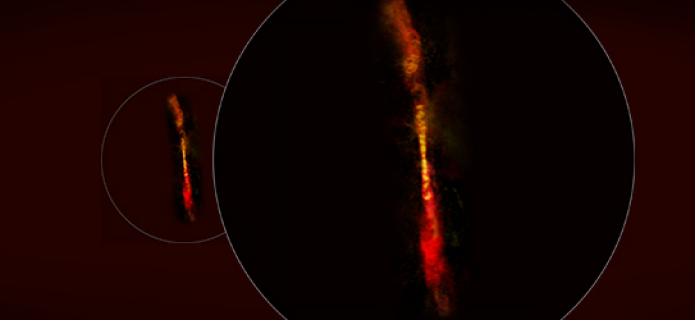ALMA Discovers Growth Spurts in a Young Protostar
4 November, 2015 / Read time: 5 minutes
Astronomers using the Atacama Large Millimeter/submillimeter Array (ALMA) have discovered an adolescent protostar that is undergoing a rapid-fire succession of growth spurts. Evidence for this fitful youth is seen in a pair of intermittent jets streaming away from the star’s poles. A paper describing these results is published in the journal Nature.
Known as CARMA-7, the protostar is one of dozens of similar objects in the Serpens South star cluster, which are located approximately 1,400 light-years from Earth. This clutch of nascent stellar objects was first detected by and named for the Combined Array for Research in Millimeter-wave Astronomy (CARMA) telescope.
"This young protostar is undergoing periods of rapid growth separated by periods of relative calm,” said Adele Plunkett, previously a National Science Foundation (NSF) graduate research fellow at Yale University and now a fellow at the European Southern Observatory (ESO) in Chile. "This punctuated stellar formation provides important insights into the chaotic interplay within this tightly packed cluster of young stars.”
All stars form in dense clouds of dust and gas. As material condenses and a star begins to evolve, surrounding material forms a flattened, rotating disk that flows onto its surface. Because of the rotational energy of the material in the disk and with the help of the star’s magnetic field, a portion of that material gets ejected from the star’s poles, forming a pair of jets that can be seen with radio telescopes like ALMA.
"The high resolution of ALMA allowed observing the emissions of carbon monoxide and get an excellent image of the structure of the young protostar". Adds José Gallardo, an ALMA operations astronomer part of the research team. "As never before, we could advance in the understanding of the process of star formation in very early stages."
In a recent survey of several protostars in the Serpens South region, astronomers were surprised to find one with brilliantly defined jets that seemed to turn on-and-off with startling regularity, alternating from one to the other in as little as 100 years possibly. The protostar and its jets are oriented in such a way that the upper jet is mostly moving away from us and the lower jet is mostly moving toward us.
Astronomers using ALMA have imaged the intermittent outflow of a young protostar known as CARMA-7. The twin jets —each nearly 2.46 trillion kilometers long— have distinct gaps, revealing that the star is growing by fits-and-starts. Credit: B. Saxton (NRAO/AUI/NSF); A. Plunkett et al.; ALMA (NRAO/ESO/NAOJ)
These prominent jets offer an otherwise hidden insight into the environment of the accretion disk surrounding the protostar. Since the accretion process is obscured by the surrounding dust and gas, the outflow is an important observational proxy. However, since many stars are forming in close proximity, astronomers needed powerful ALMA observations to disentangle the chaotic outflow activity.
The ALMA data reveal that there were 22 distinct ejection events associated with the CARMA-7 protostar. These outflows, which travel up to 2.46 trillion kilometers from the protostar, also are impacting the surrounding cluster and intermingling with other jets.
Previous observations were unable to distinguish the outflow from CARMA-7 from the surrounding outflows driven by neighboring protostars. “These sources are so young and embedded and neither optical nor near-infrared light could give a complete picture of the protostar and its outflow,” said Plunkett. “This shows how valuable ALMA is for observing a region like this.”
More information
This observation result was published by Plunkett et al. as “The episodic molecular outflow in the very young cluster Serpens South” in Nature.
The team is composed of Adele Plunkett (Astronomy Department, Yale University, USA), Héctor G. Arce (Astronomy Department, Yale University, USA), Diego Mardones (Departamento de Astronomía, Universidad de Chile, Chile), Pieter van Dokkum (Astronomy Department, Yale University, USA), Michael M.Dunham (Harvard-Smithsonian Center for Astrophysics, Cambridge, USA), Manuel Fernández-López (Instituto Argentino de Radioastronomía, Argentina), José Gallardo (Joint ALMA Observatory, Chile), Stuartt A. Corder ( Joint ALMA Observatory, Chile)
The Atacama Large Millimeter/submillimeter Array (ALMA), an international astronomy facility, is a partnership of the European Organisation for Astronomical Research in the Southern Hemisphere (ESO), the U.S. National Science Foundation (NSF) and the National Institutes of Natural Sciences (NINS) of Japan in cooperation with the Republic of Chile. ALMA is funded by ESO on behalf of its Member States, by NSF in cooperation with the National Research Council of Canada (NRC) and the Ministry of Science and Technology (MOST) in Taiwan and by NINS in cooperation with the Academia Sinica (AS) in Taiwan and the Korea Astronomy and Space Science Institute (KASI).
ALMA construction and operations are led by ESO on behalf of its Member States; by the National Radio Astronomy Observatory (NRAO), managed by Associated Universities, Inc. (AUI), on behalf of North America; and by the National Astronomical Observatory of Japan (NAOJ) on behalf of East Asia. The Joint ALMA Observatory (JAO) provides the unified leadership and management of the construction, commissioning and operation of ALMA.
Contacts:
Valeria Foncea
Education and Public Outreach Officer
Joint ALMA Observatory
Santiago, Chile
Tel: +56 2 467 6258
Cell: +56 9 75871963
E-mail: [email protected]
Masaaki Hiramatsu
Education and Public Outreach Officer, NAOJ Chile
Observatory
Tokyo, Japan
Tel: +81 422 34 3630
E-mail: [email protected]
Charles E. Blue
Public Information Officer
National Radio Astronomy Observatory
Charlottesville, Virginia, USA
Tel: +1 434 296 0314
Cell: +1 434.242.9559
E-mail: [email protected]
Richard Hook
Public Information Officer, ESO
Garching bei München, Germany
Tel: +49 89 3200 6655
Cell: +49 151 1537 3591
E-mail: [email protected]

